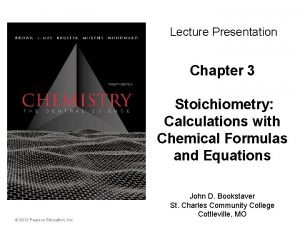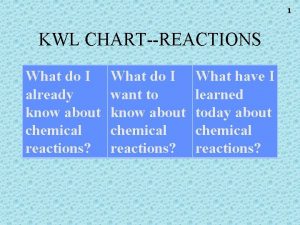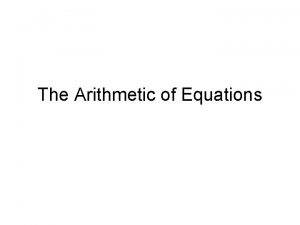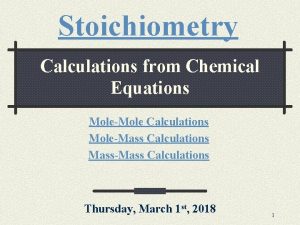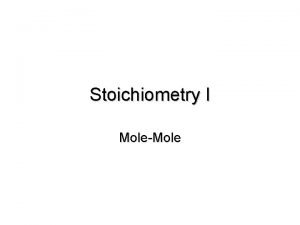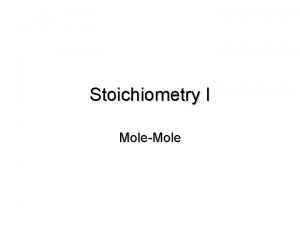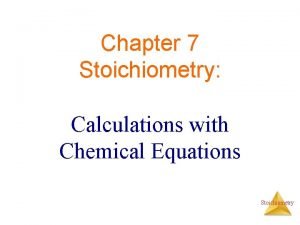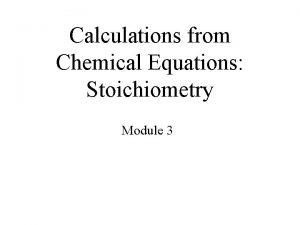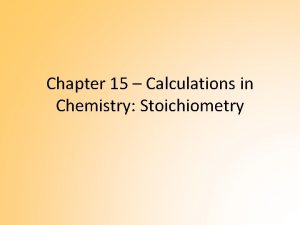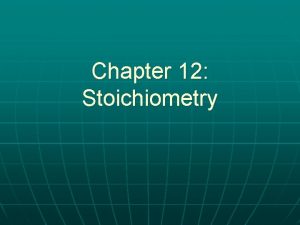Ch 9 Calculations from Chemical Equations Stoichiometry MoleMole











- Slides: 11

Ch. 9: Calculations from Chemical Equations Stoichiometry Mole-Mole Calculations Mole-Mass Calculations Mass-Mass Calculations 1

Moleville Molar Mass Railroad Mass Junction Mole Ratio Bridge Moletown Molar Mass Railroad Mass Valley

Stoichiometry: calculations based on a balanced chemical equation s r Ma Moles of “B” r Mas Grams of “A” Mole Ratio Mola ss Moles of “A” Grams of “B” Mole ratio: ratio of coefficients of any two substances in a balanced chemical equation 3

Mole-Mole Calculations How many moles of water can be obtained from the reaction of 4 moles of O 2? 2 H 2 (g) + 1 O 2 (g) → 2 H 2 O (g) 4 mol O 2 1 x 2 mol H 2 O 1 mol O 2 = 8 mol H 2 O Mole Ratio 4

How many moles of NH 3 can be obtained from the reaction of 8 moles of H 2? __ 3 H 2 (g) + __ 1 N 2 (g) → __ 2 NH 3 (g) 8 mol H 2 2 mol NH 3 x 1 3 mol H 2 = 5. 33 mol NH 3 Mole Ratio 5

Bellringers N 2 + 3 H 2 → 2 NH 3 How many moles of ammonia would be produced from 10 moles of nitrogen? 2 KCl. O 3 → 2 KCl + 3 O 2 How many moles of potassium chlorate would be needed to produce 18 moles of oxygen? Zn + 2 HCl → Zn. Cl 2 + H 2 How many moles of zinc would be needed to react with 44 moles of hydrochloric acid? 6

Mole-Mass Calculations 2 Al (s) + 6 HCl (aq) → 2 Al. Cl 3 (aq) + 3 H 2 (g) What mass of hydrogen gas can be produced by reacting 6 moles of aluminum with HCl? 6 mol Al 1 x 3 mol H 2 2 mol Al x 2. 0 g H 2 1 mol H 2 Mole Ratio = 18 g H 2 Molar Mass 7

2 Al (s) + 6 HCl (aq) → 2 Al. Cl 3 (aq) + 3 H 2 (g) What mass of HCl is needed to react with 6 moles of aluminum? 6 mol Al 6 mol HCl x 1 2 mol Al x 36. 0 g HCl 1 mol HCl Mole Ratio = 648 g HCl Molar Mass 8

Mass-Mass Calculations Sn(s) + 2 HF (g) → Sn. F 2 (s) + H 2 (g) How many grams of Sn. F 2 can be produced from the reaction of 30. 00 g of HF with Sn? 30. 00 g HF 1 mole HF 1 x x 1 mol. Sn. F 2 20. 01 g HF 2 mol HF 156. 71 g Sn. F 2 x 1 mol Sn. F 2 = 117. 5 g Sn. F 2 Molar Mass Mole Ratio 9

Limiting Reactant controls the amount of product formed. CO(g) + 2 H 2 (g) Ch 3 OH a. If 500 mol of CO react with 750 mol of H 2, which is the limiting reactant? 1. Use either given amount to calculate required amount of other. 2. Compare calculated amount to amount given H 2 b. How many moles of excess reactant remain unchanged? 125 mol CO 10

Percent yield= (actual yield/ theoretical yield)*100 Theoretical yield is the maximum amount of product that can be produced from a given amount of reactant Actual yield is the measured amount of a product obtained from a reaction Theoretical yield= 117. 5 g Sn. F 2 Actual yield = 113. 4 g Sn. F 2 Percent yield = 113. 4 g Sn. F 2 *100 117. 5 g Sn. F 2 11
 Molemole
Molemole Structural steel connection calculations calculations
Structural steel connection calculations calculations Stoichiometry and stoichiometric calculations
Stoichiometry and stoichiometric calculations Are kc and kp equal
Are kc and kp equal Translate word equations to chemical equations
Translate word equations to chemical equations The calculation of quantities in chemical equations
The calculation of quantities in chemical equations Kwl chart chemical formula
Kwl chart chemical formula Calculations using balanced equations are called
Calculations using balanced equations are called Chemical rxns/balancing equ./stoichiometry
Chemical rxns/balancing equ./stoichiometry Stoichiometry refers to
Stoichiometry refers to Types of chemical reactions and solution stoichiometry
Types of chemical reactions and solution stoichiometry Types of chemical reactions and solution stoichiometry
Types of chemical reactions and solution stoichiometry


